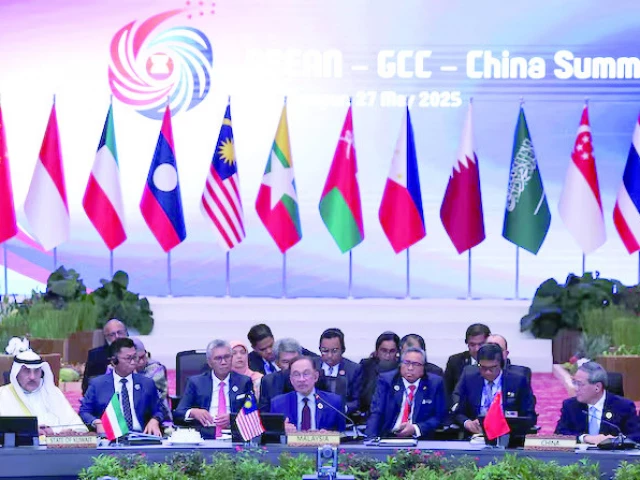Business
PSX climbs past 163,000 for the first time in history – SUCH TV

The Pakistan Stock Exchange (PSX) on Monday extended its bullish momentum at the start of a new business week to reach another all-time high as economic and geopolitical developments boosted investors’ confidence.
As trading underway, the PSX’s benchmark KSE-100 index gained 854.18 points to climb to all-time high of 163,111.18 points, marking a change of 0.53 percent.
But later profit-taking set in forcing the index to lose over 400 points to reach 162,726.32 points or 0.29 percent before noon.
Share prices of 448 companies were traded so far, out of which 264 witnessed gains and 165 losses, while 19 remained unchanged.
Experts said the recent cordial meeting between Pakistan’s civil-military leadership and US President Donald Trump has sparked positive sentiments among investors.
Furthermore, the successful resolution of Rs1,225 billion power sector circular debt has provided as a decisive step towards fiscal discipline, investor confidence through collective efforts.
This historic joint effort was led by the Prime Minister’s Task Force on Power in coordination with the Ministry of Energy, the State Bank of Pakistan, the Pakistan Banks Association, and 18 partner banks.
This landmark restructuring represented a major breakthrough in addressing one of the most chronic challenges to Pakistan’s energy sector.
On Friday, the 100-index of the Pakistan Stock Exchange (PSX) had gained 2,976.92 points, an increase of 1.87 percent, closing at 162,257.01 points.
A total of 1,714,917,163 shares valuing Rs70.744 billion were traded during the day as compared to 1,673,571,032 shares valuing Rs. 55.278 billion on the last trading day.
As many as 484 companies transacted their shares in the stock market; 228 recorded gains and 230 sustained losses, whereas the share prices of 26 remained unchanged.
The three top trading companies were WorldCall Telecom with 450,584,981 shares at Rs.1.85 per share, followed by K-Electric Limited with 112,632,537 shares at Rs.7.13 per share, and Cnergyico PK with 73,630,584 shares at Rs.8.81 per share.
The top gainers were Rafhan Maize Products Company Limited, share prices of which increased by Rs.911.15 to close at Rs.10,506.10, and Sapphire Textile Mills Limited, which rose by Rs.128.91 to close at Rs.1,422.08.
The major losers were PIA Holding Company LimitedB, which declined by Rs.1,353.22 to close at Rs.26,689.60, and Unilever Pakistan Foods Limited, which fell by Rs.148.99 to close at Rs.32,308.01.
In the futures market, 633,777,000 shares were traded as compared to 557,601,500 shares on the previous trading day, while the total value stood at Rs.35.935 billion against Rs. 27.119 billion previously.
Business
Index reshuffle: IndiGo parent to enter Sensex from Dec 22; Tata Motors Passenger Vehicles dropped – The Times of India

InterGlobe Aviation, the operator of IndiGo, will be included in the BSE’s 30-stock benchmark index Sensex from December 22, the BSE Index Services said on Saturday.As part of the reconstitution exercise, Tata Motors Passenger Vehicles Ltd will be dropped from the index, the announcement added, PTI reported.The changes will take effect from market open on Monday, December 22, and have been made by BSE Index Services Pvt Ltd (formerly Asia Index Pvt Ltd).In the broader BSE 100 index, IDFC First Bank Ltd will be added, replacing Adani Green Energy Ltd. Within the BSE Sensex 50 index, Max Healthcare Institute Ltd will be included, while IndusInd Bank Ltd will be removed.Further, in the BSE Sensex Next 50 index, IndusInd Bank and IDFC First Bank will replace Max Healthcare Institute and Adani Green Energy.
Business
India’s New Four Labour Codes: From Gratuity After One Year To Free Annual Health Checkups; Who Will Receive Gratuity In Case Of Private Sector Employee’s Death?
)
New Labour Codes In India: The Government of India has introduced a major reform that will benefit lakhs of employees who frequently change jobs, including fixed-term employees, women, gig workers, MSME staff, and contract workers. Under the new Labour Codes, the minimum service required to receive gratuity has been reduced from five years to just one year. This means more workers will now be eligible for gratuity even if they don’t stay long in one organisation.
This major reform is part of the government’s plan to replace 29 old labour laws with four new Labour Codes. These include the Code on Wages, the Industrial Relations Code, the Social Security Code, and the Occupational Safety Code, replacing outdated regulations framed between the 1930s and 1950s. The goal is to make business processes smoother, improve worker welfare, update outdated rules, and create a more transparent and worker-friendly labour system.
Gratuity: What It Is And What Happens After Private Employee’s Death
It is a one-time amount that employers give to employees as a thank-you for their service. Under the Payment of Gratuity Act, private sector employees can receive gratuity when they leave a job (due to resignation or termination), retire, or become disabled. In case of an employee’s death, the amount is paid to their nominee. Earlier, employees had to complete at least five years of continuous service with the same employer to be eligible, except in situations of death or disability. (Also Read: What Is EPS-95 Scheme? If Employee Becomes Permanently Disabled, Will He Get Pension? Check Benefits, Eligibility Criteria, And How It Is Calculated)
New Labour Codes: How New Gratuity Rule Strengthens Worker Security?
With this reform, employees will not be penalised for having short job tenures, giving young workers who often switch jobs better financial security. It also benefits contractual, fixed-term, and gig workers by making gratuity easier to receive and more predictable. By offering gratuity to more people, the government is encouraging formal employment and improving the safety net for all workers. Overall, this change makes India’s workforce more secure and brings labour benefits closer to global standards.
New Labour Codes: Benefits Including Free Annual Health Check-Ups
For the first time, all workers, whether permanent, contractual, or fixed-term, must receive appointment letters, which improves job security and helps reduce disputes. The new Labour Codes also make preventive healthcare mandatory, requiring employers to provide yearly health checkups for workers aged 40 and above, helping with early detection and lowering long-term health risks.
Under the Code on Wages, every worker across all sectors is now entitled to minimum wages, ensuring that no one falls below a basic income level. Adding further, women are allowed to work in all types of jobs, including night shifts, giving them greater employment opportunities and flexibility.
Business
Byju Raveendran Faces USD 1 Billion Default Judgment In US, Plans Appeal

Last Updated:
US court orders Byju Raveendran to repay USD 1 billion to BYJU’s Alpha and GLAS Trust Company LLC. Raveendran plans to appeal.
Byju’s founder Byju Raveendran has challenged a recent default judgment by a US bankruptcy court that holds him liable for repaying over USD 1 billion.
In a major setback, the US Delaware court has ordered Byju Raveendran, the founder of ed-tech, to repay USD 1 billion to BYJU’s Alpha and US-based GLAS Trust Company LLC, according to a report of PTI. The court has held Raveendran personally liable for the damage upon the petition filed by the lender.
The court also found that Raveendran lapsed to comply with the discovery order and continued to be evasive on several occasions. “The court will enter default judgment against Defendant Raveendran…in the amount of USD 533,000,000, and on Counts II, V and VI in the amount of USD 540,647,109.29,” the judgement said, as reported by PTI.
Byju Raveendran is going to contest the US court judgement.
In a press statement, Raveendran’s lawyers said they will “promptly appeal” the ruling, arguing that the court issued the judgment on an expedited timeline that “precluded” him from presenting his side. Raveendran has denied all allegations made in the case.
The legal team also accused GLAS Trust of misleading the Delaware Courts and the public, claiming the judgment should not have been issued at all. According to them, the court granted monetary relief even though GLAS had withdrawn its damages claim in September 2025.
“This judgment stems from an accelerated procedure triggered by serious misrepresentations made by GLAS,” the release stated. The team added that Raveendran will soon submit evidence of this alleged misconduct as part of a separate claim worth at least USD 2.5 billion, which he plans to file before the US courts.
The statement further said the latest Delaware Court ruling was a direct result of GLAS “securing judicial relief by misleading the courts,” with the aim of harming Raveendran personally and indirectly affecting other suspended directors of Think & Learn Pvt. Ltd.
Raveendran’s team also highlighted that he was given insufficient time to hire legal counsel and respond to the accelerated court actions.

Varun Yadav is a Sub Editor at News18 Business Digital. He writes articles on markets, personal finance, technology, and more. He completed his post-graduation diploma in English Journalism from the Indian Inst…Read More
Varun Yadav is a Sub Editor at News18 Business Digital. He writes articles on markets, personal finance, technology, and more. He completed his post-graduation diploma in English Journalism from the Indian Inst… Read More
November 22, 2025, 18:19 IST
Read More
-

 Tech1 week ago
Tech1 week agoNew carbon capture method uses water and pressure to remove CO₂ from emissions at half current costs
-

 Sports7 days ago
Sports7 days agoTexas A&M officer scolds South Carolina wide receiver after touchdown; department speaks out
-

 Politics1 week ago
Politics1 week agoBritish-Pakistani honoured for transforming UK halal meat industry
-

 Business1 week ago
Business1 week agoThese 9 Common Money Mistakes Are Eating Your Income
-

 Fashion1 week ago
Fashion1 week agoAfter London, Leeds and Newcastle, next stop Glasgow for busy Omnes
-

 Tech1 week ago
Tech1 week ago$25 Off Exclusive Blue Apron Coupon for November 2025
-

 Sports1 week ago
Sports1 week agoApple scrapping MLS Season Pass service in ’26
-

 Business1 week ago
Business1 week agoWhat’s behind Rachel Reeves’s hokey cokey on income tax rises?












